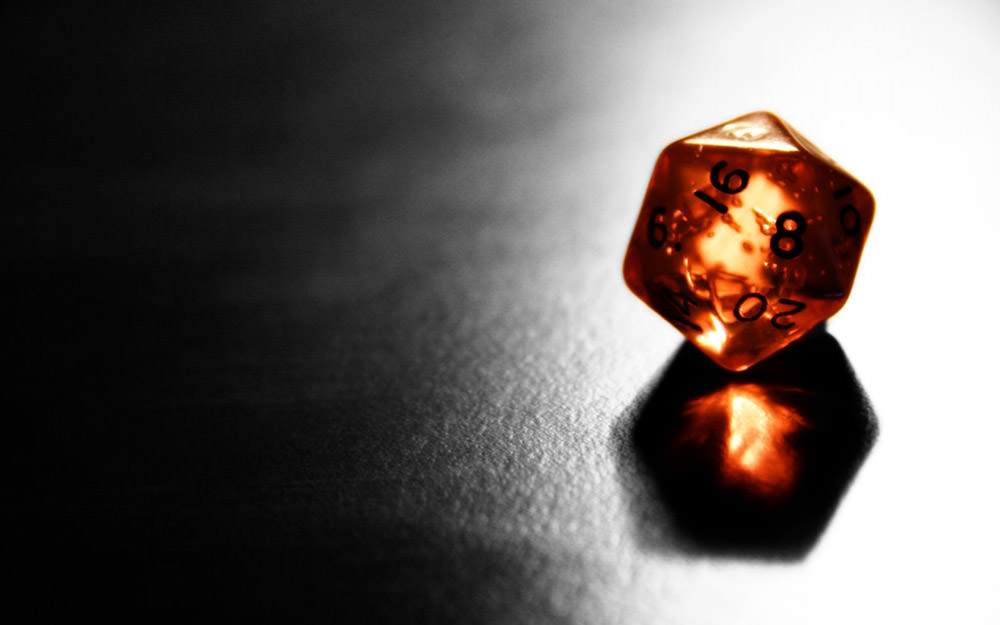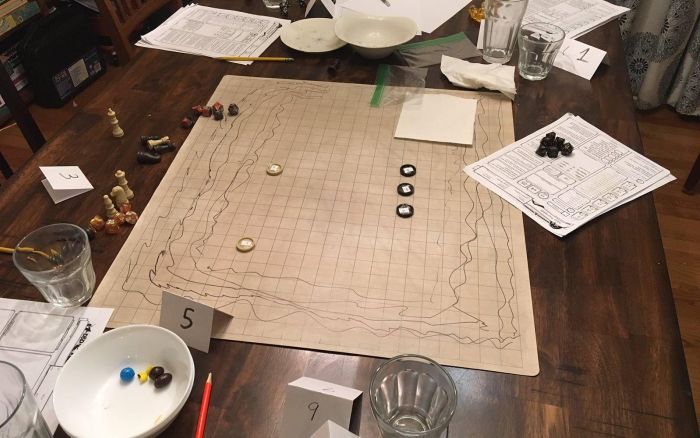Some Random Thoughts on DMing for Kids

With the weather getting colder and the nights getting longer, our kids are spending more time inside. Which can easily mean more time spent staring at screens. It can be frustrating (and guilt-inducing) when you realize your kids have spent the entire afternoon playing video games. (Or worse, watching YouTube videos of other people playing video games.)
Enter Dungeons & Dragons.
At its core, D&D is about exercising your imagination with other people in a collaborative environment. Which means the venerable role-playing game is a perfect activity for our kids and their friends. What better way to spend the cold, dark winter months than sitting around a table with your best friends, working together to explore, solve puzzles, fight monsters, and create an epic adventure?
So this past weekend, seven kids (aged 9 to 13) crammed around our dining room table with character sheets, dice, and a bunch of snacks, and dove into a custom one-shot adventure. These are a few of my thoughts and observations from the experience.
My primary goal was for everyone to have fun, especially since this was the first D&D experience for most of the kids. Therefore, I occasionally played a little loose with the rules if it meant they could attempt something awesome.
One kid (playing a halfling rogue) wanted to retrieve his party’s equipment (which been stolen by goblins) from behind a wall of fire. His plan: jump over the fire and toss a sword to his ally. I had him roll an Acrobatics check, which he made (meaning he did a sweet flip over the fire to reach the equipment). I then had him roll another check to see if he was able to successfully toss a sword to his fighter friend, which he also made. These decisions may have violated the rules concerning movement and actions in combat, but it was totally worth it to hear the table cheer when he made both checks. (In other words, I agree with Jeremy Crawford, the lead rules designer for D&D.)
Related: There’s nothing better than hearing seven kids react to somebody rolling a natural 20 on an attack.
Seven players is a lot (and in fact, we were supposed to originally have nine players). The biggest task I had was managing everyone’s attention, especially after we’d passed the three-hour mark. The only negative-ish feedback I got was that all of the dice rolling got a little boring after awhile. Which didn’t surprise me.
When you have that many players plus monsters, a round can take a long time waiting for everyone to make their dice rolls. If the same group of kids keeps playing, I’ll be researching ways to streamline combat for larger parties.
One of my biggest fears was that combat would be poorly balanced. I wanted the kids to be challenged, but not so much that combat became frustrating. Mike Shea’s guide to building encounters, with its charts for choosing monsters based on character levels, was very helpful here. (Shea’s site is packed with useful tips and information for newbie DMs like myself.)
D&D combat is fun because you get to hack, slash, and cast magic missile, but it can also be tedious. In hindsight, I wish would’ve included more exploration and problem-solving than I did. It was cool to hear the kids discuss and debate different ways to solve the few puzzles that they did encounter, and I want to encourage more such problem-solving.
As the DM, you might technically be “in charge” of the adventure. But some of the best moments occur when you loosen up and instead, let the players guide and shape the story with you reacting to their decisions. And when you’re running an adventure for kids with hyper-active imaginations, that can happen a lot.
I changed up several things in the adventure simply because of a kid’s random comment or question, and it inspired cool new twists in the story. Also, there were times when I ditched aspects of the adventure because I could tell their interest was clearing lying somewhere else.
DMs aren’t just referees and rule keepers; they’re also narrators. Which means that you need to make the story come alive for your players. And when you’re DMing for kids, one way to make the story come alive is to make it gross and over-the-top.
Did the fighter hit a zombie with his greatsword and roll high for damage? Then he split that sucker in half right down the middle. Did the wizard successfully hit that hobgoblin with a fire bolt cantrip? Then that hobgoblin’s face just got totally melted. Did the ranger roll a critical fail when shooting his longbow? Then he might have accidentally shot an ally in the butt.
(I didn’t make any during the one-shot, but Jack McDade’s advice concerning fart jokes was often in the back of my mind.)
One of my favorite aspects of D&D is the character creation process, but it can be overwhelming and time-consuming for new players. I pre-generated characters for all of the players so that we could jump right into the gaming. However, I wanted players to feel ownership of their characters, so I had them fill out a survey where they told me their preferred race and class and provided a short bio for their character. I then used that information to create their characters using D&D Beyond’s character builder.
Some of the kids got really creative with their bios, with family histories, stories of betrayal and treachery, etc., which was a) fun to read, and b) helped me create better characters.
I’ve been playing D&D for a few years now, and I still find my character sheet confusing at times. So I tried to meet with the kids before our actual adventure to explain the character sheet and all of the numbers, define terms like “armor class” and “initiative,” and describe how you actually play D&D.
I wasn’t able to meet with every kid, and of course, they all had lots of questions once we finally started playing, but I think spending an hour or so breaking down the character sheet, abilities, terms, etc., helped set their expectations and get them excited. (Who knew rolling dice and doing math could be so awesome?!)
Overall, I think the kids had a lot of fun — which was always the ultimate goal — and I definitely had fun being their DM. I got several comments about how creative the one-shot was, and it was fun to listen to them put forth theories regarding the more mysterious aspects of the storyline (which involved portals, one or two pocket dimensions or other planes, and a Weeping Angels-esque statue).
The plan is to have several more such adventures in the coming months, though I’ll probably invest in a pre-made campaign. (Creating D&D adventures is fun but it’s also a lot of work.) As a result, I suspect our dining room table is going to look like this a lot throughout the winter — and I can’t wait.
